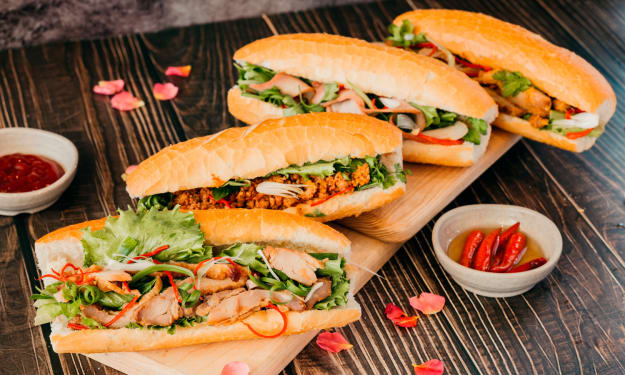Beef noodles (Phở or Pho) in USA
Vietnamese cuisine

Yummy yummy yummy
Phở originated in the early 20th century in Northern Vietnam, and after the Vietnam War, refugees popularized it throughout the world.
Phở likely evolved from similar noodle dishes. Its origins will always be debated, but the emphasis on beef in Vietnamese cuisine and the dish's evolution is likely attributed to French influence.[citation needed] For example, villagers in Vân Cù say they ate phở long before the French colonial period. The modern form emerged between 1900 and 1907 in northern Vietnam, southeast of Hanoi in Nam Định Province, then a substantial textile market. The traditional home of phở is reputed to be the villages of Vân Cù and Dao Cù (or Giao Cù) in Đông Xuân commune, Nam Trực District, Nam Định Province.
Pho, a traditional Vietnamese noodle soup, has become a beloved dish in the United States, reflecting the country's growing appreciation for global cuisine. The history of pho in the U.S. is intertwined with the waves of Vietnamese immigration that began in earnest after the Vietnam War in the 1970s. As Vietnamese communities established themselves, especially in states like California, Texas, and Virginia, they brought their culinary traditions with them, introducing Americans to the rich, aromatic flavors of pho.
Pho is typically made with a clear broth, rice noodles, herbs, and meat, usually beef (pho bo) or chicken (pho ga). The broth is simmered for hours with ingredients such as bones, ginger, onions, and spices like star anise, cinnamon, and cloves, creating a complex, savory flavor. It is often served with a side of fresh herbs, bean sprouts, lime, and chili peppers, allowing diners to customize their bowls to their liking.
In the aftermath of the Vietnam War, Vietnamese refugees brought pho to many countries. Restaurants specializing in phở appeared in numerous Asian enclaves and Little Saigons, such as in Paris and in major cities in the United States, Canada and Australia. In 1980, the first of hundreds of phở restaurants opened in the Little Saigon in Orange County, California.
In the United States, phở began to enter the mainstream during the 1990s, as relations between the U.S. and Vietnam improved. At that time Vietnamese restaurants began opening quickly in Texas and California, spreading rapidly along the Gulf and West Coasts, as well as the East Coast and the rest of the country. During the 2000s, phở restaurants in the United States generated US$500 million in annual revenue, according to an unofficial estimate. Phở can now be found in cafeterias at many college and corporate campuses, especially on the West Coast.
The word "pho" was added to the Shorter Oxford English Dictionary in 2007. Phở is listed at number 28 on "World's 50 most delicious foods" compiled by CNN Go in 2011. The Vietnamese Embassy in Mexico celebrated Phở Day on April 3, 2016, with Osaka Prefecture holding a similar commemoration the following day. Phở has been adopted by other Southeast Asian cuisines, including Lao and Hmong cuisine. It sometimes appears as "Phô" on menus in Australia.
In the U.S., pho has evolved in various ways. Traditional pho restaurants, often family-owned, can be found in Vietnamese neighborhoods and major cities, offering authentic recipes passed down through generations. At the same time, contemporary interpretations of pho have emerged, with chefs experimenting with different ingredients and techniques. These modern takes on pho can be found in fusion restaurants, food trucks, and even high-end dining establishments.
Pho's popularity in the U.S. can be attributed to several factors. Its comforting, hearty nature makes it a favorite in colder weather, and its perceived health benefits appeal to those seeking nutritious meal options. The communal aspect of sharing pho, with its customizable toppings and interactive dining experience, also contributes to its appeal.
Additionally, the rise of foodie culture and the increasing interest in diverse culinary experiences have boosted pho's visibility. Food blogs, social media, and television shows have played significant roles in introducing pho to a wider audience, showcasing the dish's versatility and depth of flavor.
The accessibility of pho has also improved, with Asian supermarkets and mainstream grocery stores now stocking essential ingredients, making it easier for home cooks to prepare the dish. This has further cemented pho's place in American cuisine, allowing more people to enjoy and experiment with it in their kitchens.
Overall, pho's journey in the United States is a testament to the country's dynamic food culture, where traditional recipes are honored and new culinary ideas are constantly explored. As pho continues to gain popularity, it remains a delicious symbol of cultural exchange and the rich, diverse tapestry of American dining.
About the Creator
Tho Le
My name is Tho Le. My hobbies are music, movies, discover, learning. I have 1 boy who is 15yrs old.
Enjoyed the story? Support the Creator.
Subscribe for free to receive all their stories in your feed. You could also pledge your support or give them a one-off tip, letting them know you appreciate their work.






Comments
There are no comments for this story
Be the first to respond and start the conversation.